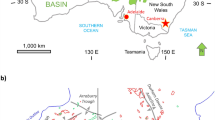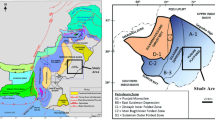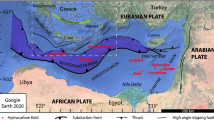Abstract
Hydrocarbon source rocks are characterized by the hydrocarbon discharge, and the alteration and variation in organic compositions and organic content due to the enhanced thermal maturation. These variations throw constraints on the application of the conventional inversion evaluation of hydrocarbon potential by assessing the residual organic matter left in source rocks. Geobiology, probing the interaction between the life system and the earth system, provides new principles in deciphering the whole dynamic processes related to the organic evolution history from living biomass to organic burial. Geobiological subdisciplines, including molecular geobiology, geomicrobiology, geoecology and biogeochemistry, offer new methodology and techniques to estimate the paleoproductivity, depositional organics and organic burial capacity and their components. Geobiofacies, newly proposed herein, is terminologized to define the geobiological dynamic processes through the combination of biofacies with organic facies and sedimentary facies, and expressed by the biohabitat types, paleoproductivity, depositional and preserved organics. Geobiofacies is identified as a useful means to create the geobiological evaluation system, which in turn rectifies the conventional evaluation system for the marine source rocks.
Similar content being viewed by others
References
Amend J P, Fedo C, Cady S L, et al (2001). Dialogue: Geobiology and geomicrobiology in the 21st century. GSA Today, 11: 10
Banerjee A, Jha M, Mittal A K, et al (2000). The effective source rocks in the north Cambay basin, India. Marine and Petroleum Geology, 17: 1,111–1,129
Banfield J F, Nealson K H (1997). Geomicrobiology: Interactions between microbes and minerals. Review in Mineralogy. Washington DC: Mineralogical Society of America
Beard B L, Johnson C M (2004). Fe isotope variations in the modern and ancient earth and other planetary bodies. Reviews in Mineralogy and Geochemistry, 55: 319–357
Brocks J J, Logan G A, Buick R, et al (1999). Archean molecular fossils and the early rise of eukaryotes. Science, 285: 1033–1036
Brocks J J, Pearson A (2005). Building the biomarker tree of life. Rev Mineral Geochem, 59: 233–258
Clegg H, Wilkes H, Horsfield B (1997). Carbazole distributions in carbonate and clastic source rocks. Geochimica et Cosmochimica Acta, 61: 5,335–5,345
Demaison G J, Moore G T (1980). Anoxic environments and oil source bed genesis. Organic Geochemistry, 2: 9–31
Dutkiewicz A, Volk H, Ridley J, et al (2003). Biomarkers, brines, and oil in the Mesoproterozoic, Roper Superbasin, Australia. Geology, 31(11): 981–984
Ercegovac M, Kostić A (2006). Organic facies and palynofacies: Nomenclature, classification and applicability for petroleum source rock evaluation. International Journal of Coal Geology, 68: 70–78
Fildani A, Hanson A D, Chen Z, et al (2005). Geochemical characteristics of oil and source rocks and implications for petroleum systems, Talara Basin, northwest Peru. AAPG Bulletin, 89: 1,519–1,545
Glikson M (2001). The application of electron microscopy and microanalysis in conjunction with organic petrology to further the understanding of organic-mineral association; examples from Mount Isa and McArthur basins, Australia. International Journal of Coal Geology, 47: 139–159
Gong Y, Xu R, Feng Q, et al (2007). Hypersaline and anoxia in the Devonian Frasnian-Famennian transition: Molecular fossil and mineralogical evidences from Guangxi, South China. Frontier of Earth Science in China, this issue
Grice K, Cao C, Love G D, et al (2005). Photic zone euxinia during the Permian-Triassic superanoxic event. Science, 307: 706–709
Gu S, Zhang M, Gui B, et al (2007). An attempt to quantitatively reconstruct the primary productivity by counting the radiolarian fossils in cherts from the latest Permian Dalong Formation in southwestern China. Frontier of Earth Science in China, this issue
Henderson G M (2002). New oceanic proxies for paleoclimate. Earth and Planetary Science Letters, 203: 1–13
Holbourn A E, Kuhnt W, Söding E (2001). Atlantic paleobathymetry, paleoproductivity and paleocirculation in the late Albian: The benthic foraminiferal record. Palaeogeography, Palaeoclimatology, Palaeoecology, 170: 171–196
Hu C, Pan H, Ma Z, et al (2007). Iron abundance in the marine carbonate as a proxy of the paleo-productivity in hydrocarbon source rocks. Earth Science—Journal of China University of Geosciences, in press
Huc A Y, Bertrand P, Stow D A V (2000). Depositional processes of source rocks in deep offshore settings; Quaternary analogs. In: Annual Meeting Expanded Abstracts-American Association of Petroleum Geologists. 70
Jin Z, Zhang Y, Chen S (2000). Fluctuating tectonic and sedimentary processes in Tarim basin. Science in China (D), 35(6): 530–539
Jorissen F J, Rohling E J (2000). Faunal prespectives on paleoproductivity. Marine Micropaleontology, 40(3): 131–134
Kang Y (2004). Distribution of the oil and gas in the main basins in China and the exploration experience. Urumqi: Science and Technology Press of Xinjiang
Katz B J (2005). Controlling factors on source rock development; a review of productivity, preservation, and sedimentation rate. In: Harris N B, ed. The deposition of organic-carbon-rich sediments; models, mechanisms, and consequences. Special Publication-Society for Sedimentary Geology, 82: 7–16
Knoll A H (2003). The geological consequences of evolution. Geobiology, 1: 3–14
Knoll A H, Hayes J M (1997). Geobiology: Articulating a concept. In: Lane R H, Lipps J, Steininger F F, et al., eds. Paleontology in the 21st Century. Frankfurt, International Senckenberg Conference. Kleine Senckenberg, 25: 105–108
Knoll A H, Hayes J M (2000). Geobiology: Problems and prospects. In: Lane R H, Steininger F F, Kaesler R L, et al., eds. Fossils and the Future: Paleontology in the 21st Century. Senckenberg-Buch, 74: 149
Kump L R, Arthur M A (1999). Interpreting carbon isotope excursions: Carbonates and organic matter. Chemical Geology, 161: 181–198
Kuypers M M M, van Breugel Y, Schouten S, et al (2004). N2-fixing cyanobacteria supplied nutrient N for Cretaceous oceanic anoxic events. Geology, 32: 853–856
Lash G G, Engelder T (2005). An analysis of horizontal microcracking during catagenesis; example from the Catskill Delta complex. AAPG Bulletin, 89: 1433–1449
Leythaeuser D (1988). Geochemical effects of primary migration of petroleum in Kimmeridge source rocks from Brae Field Area, North Sea, I: Gross composition of C+ 15 saturated hydrocarbons. Geochim Cosmochim Acta, 52(6): 701–713
Liang D, Chen J (2005). Source and oil correlation in the high-post mature marine strata in China. Petroleum Exploration and Exploitation, 32(4): 8–14
Ma Y (2006). Exploration of marine oil and gas fields in China: Exemplified by the Puguang large gas filed in Sichuan basin. Marine Oil and Gas Geology, 11(2): 35–40
Mucci A, Sundby B, Gehlen M, et al (2000). The fate of carbon in continental shelf sediments of eastern Canada: A case study. Deep-Sea Research II, 47: 733–760
Noffke N (2005). Geobiology—A holistic scientific discipline. Palaeogeography, Palaeoclimatology, Palaleoecology, 219: 1–3
Parrish J T (1982). Upwelling and petroleum source beds with reference to Palaeozoic. AAPG Bulletin, 66: 750–774
Pedersen T F, Calvert S E (1990). Anoxia vs productivity: What controls the formation of organic-carbon-rich sediments and sedimentary rock? AAPG Bulletin, 74: 454–466
Pennisi E (2002). Geobiologists: As diverse as the bugs they study. Science, 296: 1,058–1,060
Priscu J C, Adams E E, Lyons W B, et al (1999). Geomicrobiology of subglacial ice above Lake Vostok, Antarctica. Science, 286: 2,141–2,144
Qin J, Zheng L, Tenger (2007). Study on restitution coefficient of original content of total organic carbon for high mature marine source rocks. Frontier of Earth Science in China, this issue
Rabbani A R, Kamali M R (2005). Source rock evaluation and petroleum geochemistry, offshore SW Iran. Journal of Petroleum Geology, 28: 413–428
Rasmussen B (2005). Evidence for pervasive petroleum generation and migration in 3.2 and 2.63 Ga shales. Geology, 33: 497–500
Riding R, Liang L (2005). Geobiology of microbial carbonates: Metazoan and seawater saturation state influences on secular trends during the Phanerozoic. Palaeogeography, Palaeoclimatology, Palaeoecology, 219: 101–115
Riediger C, Carrelli G G, Zonneveld J P (2004). Hydrocarbon source rock characterization and thermal maturity of the Upper Triassic Baldonnel and Pardonet Formations, northeastern British Columbia, Canada. Bulletin of Canadian Petroleum Geology, 52: 277–301
Severmann S, Larsen O, Palmer M R, et al (2002). The isotopic signature of Fe-mineralization during early diagenesis. Geochimica et Cosmochimica Acta, 66: A698
Sharaf L M (2003). Source rock evaluation and geochemistry of condensates and natural gases, offshore Nile Delta, Egypt. Journal of Petroleum Geology, 26: 189–209
Shen G, Shi B (2002). Oceanographic Ecology. Beijing: Science Press
Siebert C, McManus J, Bice A, et al (2006). Molybdenum isotope signatures in continental margin marine sediments. Earth and Planetary Science Letters, 241: 723–733
Stein R (2004). Origin of marine petroleum source rocks from the Late Jurassic to Early Cretaceous Norwegian Greenland Seaway; evidence for stagnation and upwelling. Marine and Petroleum Geology, 21: 157–176
Summons R E, Jahnke L L, Hope J M, et al (1999). 2-methylhopanoids as biomarkers for cyanobacterial oxygenic photosynthesis. Nature, 400: 554–557
Tyson R V (2005). The “productivity versus preservation” controversy; cause, flaws, and resolution. In: The deposition of organicarbon-rich sediments; models, mechanisms, and consequences. Harris-Nicholas-B, Special Publication-Society for Sedimentary Geology, 82: 17–33
Tyson R V, Pearson T H (1991). Modern and ancient continental shelf anoxia. Geological Society of Special Publication, 58: 470–482
Voigt S, Gale A S, Voigt T (2006). Sea-level change, carbon cycling and palaeoclimate during the Late Cenomanian of northwest Europe; an integrated palaeoenvironmental analysis. Cretaceous Research, 27: 836–858
Walker J J, Spear J R, Pace N R, et al (2005). Geobiology of a microbial endolithic community in the Yellowstone geothermal environment. Nature, 434: 1011–1014
Wang H, Ma X, Liu D, et al (2007). Chemical variation from biolipids to sedimentary organic matter in modern oceans and its implication to the geobiological evaluation of hydrocarbon source rocks. Frontier of Earth Science in China, this issue
Wilde P, Timothy W L, Quinby-Hunt M S (2004). Organic carbon proxies in black shales: Molybdenum. Chemical Geology, 206: 167–176
Xie S, Gong Y, Tong J, et al (2006). Advancement from paleontology to geobiology. Chinese Science Bulletin, 51(19): 2327–2336
Xie S, Pancost R D, Yin H, et al (2005). Two episodes of microbial change coupled with Permo/Triassic faunal mass extinction. Nature, 434: 494–497
Xie X, Yin H, Xie S (2007). Comparison on forward and inverse analysis methods of marine hydrocarbon source rocks. Earth Science—Journal of China University of Geosciences (in press)
Yan J, Liu X (2007). Geobiological interpretation of the oxygen-deficient deposits of the middle Permian marine source rocks in South China: A working hypothesis. Frontier of Earth Science in China, this issue
Yang H, Wang Y, Chen L, et al (2007). Calci-microbialite as a potential source rock and its geomicrobiological processes. Frontier of Earth Science in China, this issue
Yin H, Yang F, Xie S, et al (2004). Biogeology. Wuhan: Science and Technology Press of Hubei
Younes M A (2001). Source rock-dependent biomarker properties and stable carbon isotopic composition of crude oils from West Bakr Fields, onshore Gulf of Suez, Egypt; a case study. Annual Meeting Expanded Abstracts—AAPG, 222
Younes M A (2003). Hydrocarbon seepage generation and migration in the southern Gulf of Suez, Egypt; insights from biomarker characteristics and source rock modeling. Journal of Petroleum Geology, 26: 211–224
Younes M A, Philp R P (2005). Source rock characterization based on biological marker distributions of crude oils in the southern Gulf of Suez, Egypt. Journal of Petroleum Geology, 28(3): 301–317
Zhang Y, He W, Feng Q (2007). A preliminary biogeochemistry-based quantification of primary productivity of end-Permian deep-water basin at Dongpan Section, Guangxi, South China. Frontier of Earth Science in China, this issue
Zhou L, Zhou H, Li M, et al (2007). Molybdenum isotope signatures from Yangtze block continental margin and its indication to organic burial rate. Frontier of Earth Science in China, this issue
Author information
Authors and Affiliations
Corresponding author
Additional information
__________
Translated from Earth Science—Journal of China University of Geosciences, 2007, 32(6): 727–740 [译自: 地球科学—中国地质大学学报]
Rights and permissions
About this article
Cite this article
Shucheng, X., Yin, H., Xie, X. et al. On the geobiological evaluation of hydrocarbon source rocks. Front. Earth Sci. China 1, 389–398 (2007). https://doi.org/10.1007/s11707-007-0041-2
Issue Date:
DOI: https://doi.org/10.1007/s11707-007-0041-2




